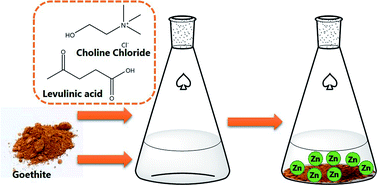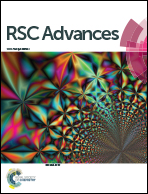Selective recovery of zinc from goethite residue in the zinc industry using deep-eutectic solvents†
Abstract
Several deep-eutectic solvents (DESs) were tested for the valorisation of goethite residue produced by the zinc industry. The objective of the work was to selectively recover zinc from the iron-rich matrix using deep-eutectic solvents as lixiviants. The effect of the type of hydrogen bond donor and hydrogen bond acceptor of the deep-eutectic solvent on the leaching efficiency was studied. Levulinic acid–choline chloride (xChCl = 0.33) (LevA–ChCl) could selectively leach zinc from the iron-rich matrix, and it was selected as the best-performing system to be used in further study. The leaching process was optimised in terms of temperature, contact time, liquid-to-solid ratio and water content of the deep-eutectic solvent. The role of the choline cation on the leaching process was investigated by considering the leaching properties of a LevA–CaCl2 mixture. The goethite residue was also leached with pure levulinic acid. The results were compared to a purely hydrometallurgical approach using sulphuric acid leaching. Leaching with LevA–ChCl resulted in higher selectivity compared to the conventional “hot leaching” with 80 g L−1 sulphuric acid. Furthermore, a slightly higher zinc recovery and comparable selectivity for zinc over iron were achieved with LevA–ChCl compared to conventional “neutral leaching” with 10 g L−1 sulphuric acid.



 Please wait while we load your content...
Please wait while we load your content...